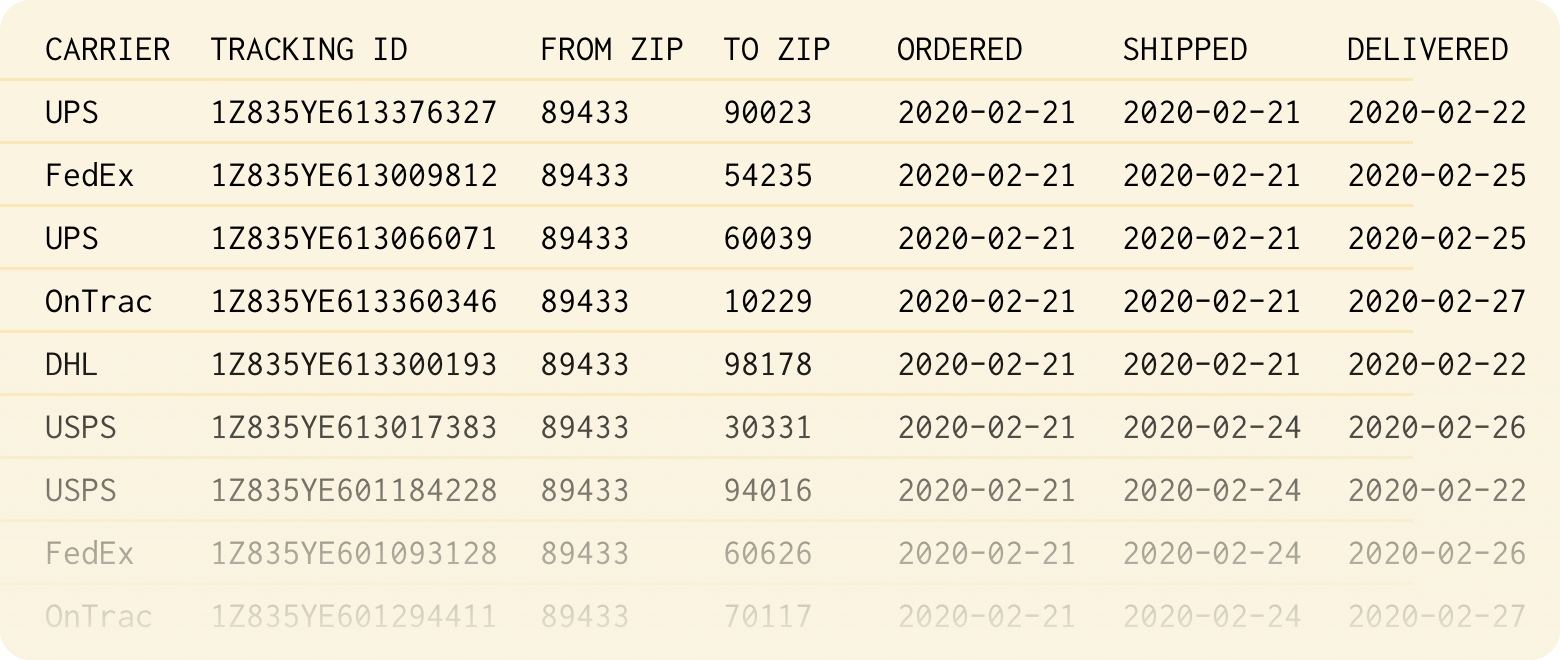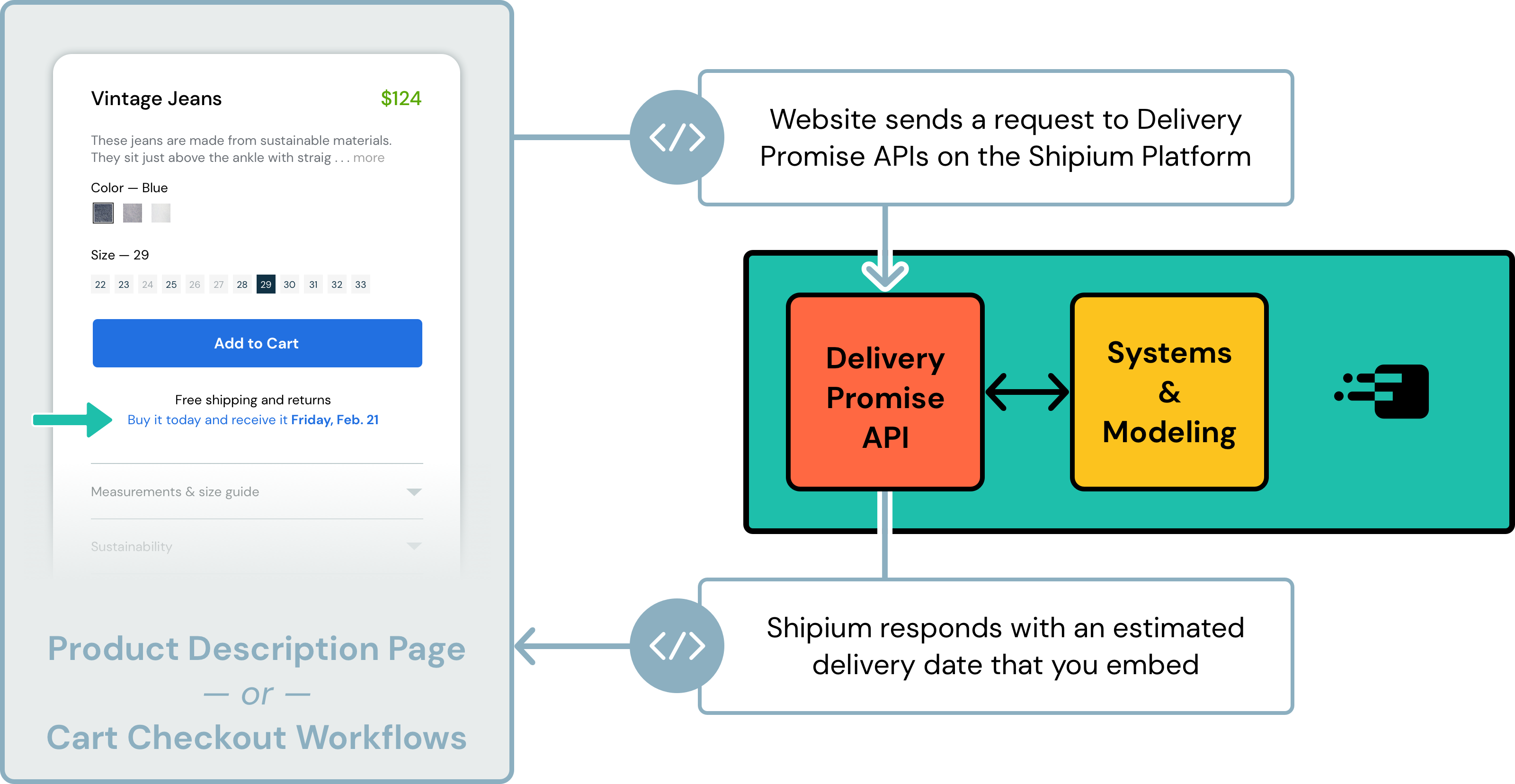Shipium Specs Delivery Promise
Understand how the service works and requirements for integration.
Initial Setup
The Shipium platform is able to make more accurate delivery estimates because of superior data modeling. The data science we use is pulled from decades of experience building similar core technology at Amazon and Zulily.
Historical shipping performance is the key dataset that powers our modeling. As a result, all customers must complete an initial data upload of historical shipping data in order to fine-tune the algorithms to their unique business.
Customers get started by working with the Shipium team to set up an account for the organization and an initial set of users. Once the account is created, customers upload their historical data and set up their fulfillment network on the platform.
Historical Shipping Data
Description
The Shipium platforms makes several calculations based on stochastic modeling of historical shipping data. If we calculate shipping from State X to State Y typically takes 2 days versus the standard carrier SLA of 5 days, then that is how we are able to return an estimated delivery date of 2 days instead of using the standard 5 days you would have used. Uploading around 6-12 months of historical shipping data provides everything needed.
Example configuration
- Export shipping data from existing TMS, OMS, or WMS systems.
- We provide a guide of which data points and formatting is needed.

Shipping Data Required
| Customer Country | The 2-letter country code for your customer’s shipping address. |
|---|---|
| Customer Postal Code | The country-specific postal code for your customer’s shipping address. |
| Ships from Country | The 2-letter country code for the shipping warehouse. |
| Ships from Postal Code | The country-specific postal code for the shipping warehouse. |
| Ordered Timestamp | Date & time that your customer ordered the item. |
| Shipped Timestamp | Date & time that your fulfillment center shipped the item to your customer. |
| Product ID | Your product ID for this product. |
| Carrier Name | The carrier for your customer’s outbound shipment (e.g. UPS, FedEx). |
| Carrier Tracking ID | Carrier-specific tracking identifier. |
| Delivery Timestamp | Date & time that the carrier delivered the product to your customer. |
| Product Category | A Partner-specific category for the product (e.g. “book”). |
| Package Linear Unit | The unit for height, width and length. One of “FT”, “IN”, “M”, or “CM”. |
| Package Height | The linear height of the package in package_linear_unit(s). |
| Package Length | The linear length of the package in package_linear_unit(s). |
| Package Width | The linear width of the package in package_linear_unit(s). |
| Package Weight Unit | The unit of weight for package_weight. One of “LB”, “OZ”, “KG” or “G”. |
| Package Weight | The weight of the package in package_weight_unit(s). |
| Packaging Type | Type of packaging used to ship the product. “BOX”, “BAG” and “TUBE” are the valid values. |
| Is Dropship | “true” if the product was drop-shipped. “false” otherwise. |
Fulfillment Centers
Description
The majority of fulfillment decisions stem off an understanding of where shipments are shipping from. Getting a graph of your fulfillment network setup is a unique and critical part of using Shipium's platform.
Example configuration
- For each FC in your network, provide details like location and cut-off times.
Where Delivery Promise Fits
The service's APIs are integrated into product description pages (PDPs) and cart checkout workflows. Wherever you have a SKU where you wish to project an accurate and aggressive estimated delivery date, you can make a call and display the result we return back to you.

How It Works
Delivery Promise is consumed via a set of system-to-system level APIs that sit on the Shipium platform. You make an API call to Shipium, and we provide a response.
What you send to us
- Customer destination location (typically comes from a logged in user address or at minimum an IP address estimation)
- Which FC the order is shipping from
- SKU dimweight properties
What we return
- An estimated delivery date based on predetermined policies you set